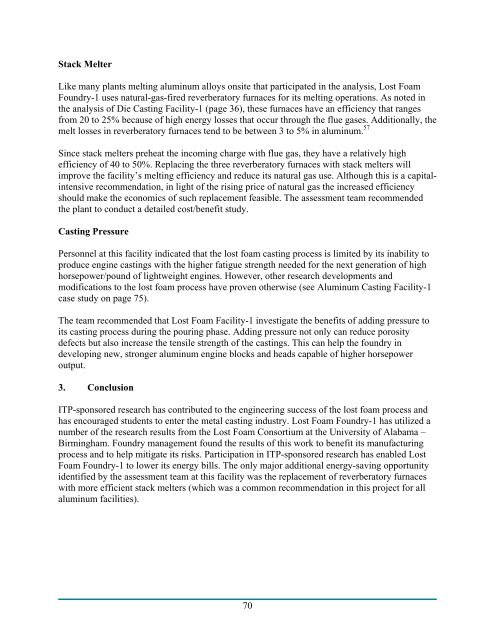Implementation of Metal Casting Best Practices - EERE - U.S. ...
Implementation of Metal Casting Best Practices - EERE - U.S. ...
Implementation of Metal Casting Best Practices - EERE - U.S. ...
Create successful ePaper yourself
Turn your PDF publications into a flip-book with our unique Google optimized e-Paper software.
Stack Melter<br />
Like many plants melting aluminum alloys onsite that participated in the analysis, Lost Foam<br />
Foundry-1 uses natural-gas-fired reverberatory furnaces for its melting operations. As noted in<br />
the analysis <strong>of</strong> Die <strong>Casting</strong> Facility-1 (page 36), these furnaces have an efficiency that ranges<br />
from 20 to 25% because <strong>of</strong> high energy losses that occur through the flue gases. Additionally, the<br />
melt losses in reverberatory furnaces tend to be between 3 to 5% in aluminum. 57<br />
Since stack melters preheat the incoming charge with flue gas, they have a relatively high<br />
efficiency <strong>of</strong> 40 to 50%. Replacing the three reverberatory furnaces with stack melters will<br />
improve the facility’s melting efficiency and reduce its natural gas use. Although this is a capitalintensive<br />
recommendation, in light <strong>of</strong> the rising price <strong>of</strong> natural gas the increased efficiency<br />
should make the economics <strong>of</strong> such replacement feasible. The assessment team recommended<br />
the plant to conduct a detailed cost/benefit study.<br />
<strong>Casting</strong> Pressure<br />
Personnel at this facility indicated that the lost foam casting process is limited by its inability to<br />
produce engine castings with the higher fatigue strength needed for the next generation <strong>of</strong> high<br />
horsepower/pound <strong>of</strong> lightweight engines. However, other research developments and<br />
modifications to the lost foam process have proven otherwise (see Aluminum <strong>Casting</strong> Facility-1<br />
case study on page 75).<br />
The team recommended that Lost Foam Facility-1 investigate the benefits <strong>of</strong> adding pressure to<br />
its casting process during the pouring phase. Adding pressure not only can reduce porosity<br />
defects but also increase the tensile strength <strong>of</strong> the castings. This can help the foundry in<br />
developing new, stronger aluminum engine blocks and heads capable <strong>of</strong> higher horsepower<br />
output.<br />
3. Conclusion<br />
ITP-sponsored research has contributed to the engineering success <strong>of</strong> the lost foam process and<br />
has encouraged students to enter the metal casting industry. Lost Foam Foundry-1 has utilized a<br />
number <strong>of</strong> the research results from the Lost Foam Consortium at the University <strong>of</strong> Alabama –<br />
Birmingham. Foundry management found the results <strong>of</strong> this work to benefit its manufacturing<br />
process and to help mitigate its risks. Participation in ITP-sponsored research has enabled Lost<br />
Foam Foundry-1 to lower its energy bills. The only major additional energy-saving opportunity<br />
identified by the assessment team at this facility was the replacement <strong>of</strong> reverberatory furnaces<br />
with more efficient stack melters (which was a common recommendation in this project for all<br />
aluminum facilities).<br />
70

















